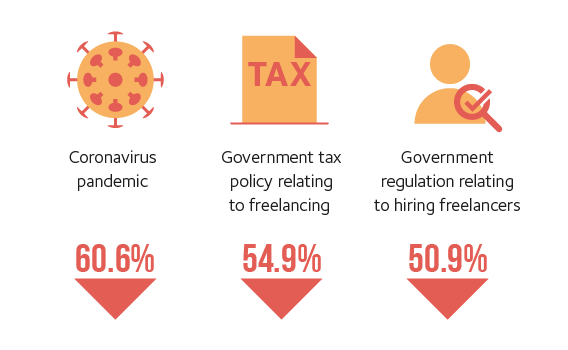Average quarterly earnings by UK freelancers fell 10% in the second quarter to £18,652, but on track to rise
Freelancers cut their own day rates to £397 in the second quarter from £445 in the first quarter — lower than during the pandemic and lowest overall since 2018, according to a report released by IPSE.
IPSE reported there are fewer contracts available, prompting freelancers to cut their rates. IR35 was a contributing factor for the decrease in contracts.

Similarly, in Q1 2021, government regulation relating to hiring freelancers (72.9%) was the most cited factor negatively affecting freelancers’ business performance, whereas in Q2 2021, it is now cited as the third factor for lowering freelancers’ business performance (50.9%), reported IPSE.
Government tax policy relating to freelancing continues to have a “detrimental effect” on many freelancers’ businesses, in fact, looking at SOC 2 professional freelancers, 71.8% cite this as a negative influencer. This is most likely due to the implementation of IR35 changes and the question of how to continue securing contracts ‘outside IR35’.
Government tax policy relating to freelancing continues to have a “detrimental effect” on many freelancers’ businesses, in fact, looking at SOC 2 professional freelancers, 71.8% cite this as a negative influencer.
IPSE
“It is now clear — as we feared — that the changes to IR35 were introduced into the private sector at the very worst time: just when they were most likely to hamstring the freelance recovery,” said Staffing Industry Analysts.
“Now just when there should be a surge in freelance work to support the wider economic recovery, many freelancers are finding themselves competitively slashing their day rates to fight it out over fewer contracts,” said the Staffing advisor.
There is some silver lining in all of this, which is freelancer’s average quarterly earnings are higher than the second quarter of 2020 when they reached a record low of £15,709.
“The fact that quarterly earnings are now higher than in Q2 2020 (£15,709) suggests that the easing of some restrictions has benefited freelancers but the fact that it falls short of the same quarter in 2019 (£20,480) can be attributed to spare capacity remaining high and day rates falling,” according to IPSE.
Overall, it is expected that over the next 12 months, day rates will increase by an average of 8.7% which is largely driven by the fact that SOC1 managerial and SOC3 associate professional and technical freelancers expect an increase to their day rates of 19.4 % and 9.4 % respectively. SOC2 professional freelancers, however, only anticipate an increase of 0.8 % in their day rates over the next 12 months.
IPSE
“The freelance sector is clearly raring to go,” said the freelancer association, “but is materially held up by the impact of the IR35 changes working through the contracting market.
“This may indicate an opportunity for government to boost the freelancing sector and thereby aid the economic recovery effort: by clearing the uncertainty and confusion left by the changes to IR35.”



 Have you dropped your rates? What was the driving factor and do you think you’ll be able to raise them later this year? Leave your comments.
Have you dropped your rates? What was the driving factor and do you think you’ll be able to raise them later this year? Leave your comments.